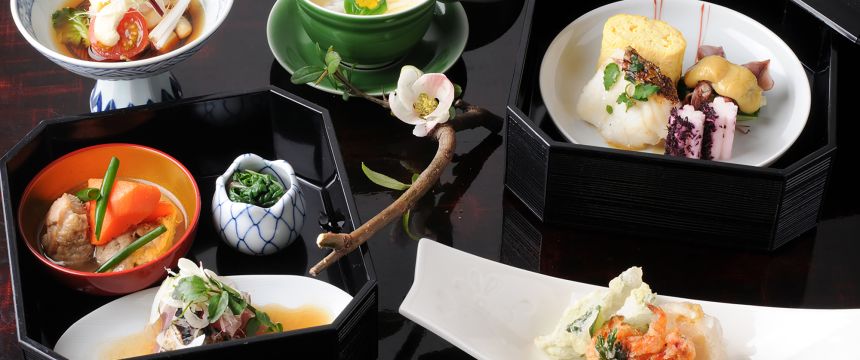Izu Peninsula, Shizuoka Prefecture - Tokai
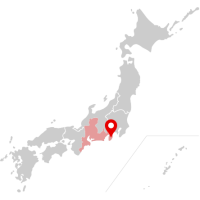
Nestled deep in the mountains of the Izu Peninsula lies a perfectly balanced ecosystem responsible for one of the most iconic flavors of Japanese cuisine, both traditional and contemporary. Izu has been the home of Japanese wasabi for more than four hundred years, and if you have ever eaten freshly grated wasabi in a Japanese restaurant, it most likely came from the Izu region.
But if you have tasted wasabi only as a paste, then you can’t really say you have tasted wasabi. For the definitive wasabi experience, you owe it to yourself to take the short trip from Tokyo or Osaka to Shizuoka Prefecture, which lies in the shadow of Mt. Fuji, where you can taste the difference for yourself.
Whether you enjoy it with sushi, Japanese beef, or any number of classic and contemporary dishes, Izu wasabi promises to be a revelation.
Sculpted by Human Ingenuity and Nature’s Hand

So, what makes Shizuoka, and Izu in particular, the perfect place for premium wasabi? This relatively small area is ranked first in the country for both the amount of wasabi produced and its sales volume. The answer lies in the combination of the ingenious traditional farming method used here and the mountain climate, which seems to have been specially made for wasabi.

The ample supply of mountain-spring water is an important piece of the puzzle, as is the rocky terrain that would normally be a barrier to growing crops. But it was the farmers’ development of thetatamiishi system of wasabi fields that completes the picture. Here, beds of rocks are layered down to create fields within fields, with channels of water running between them. Spaces between larger rocks at the base of the beds create a subterranean drainage system, while toward the top of the beds, the rocks become gradually smaller, creating a stable but highly permeable surface where water moves in a steady flow. This regulates the water temperature and keeps a constant supply of oxygen and nutrients flowing directly to the wasabi plants.
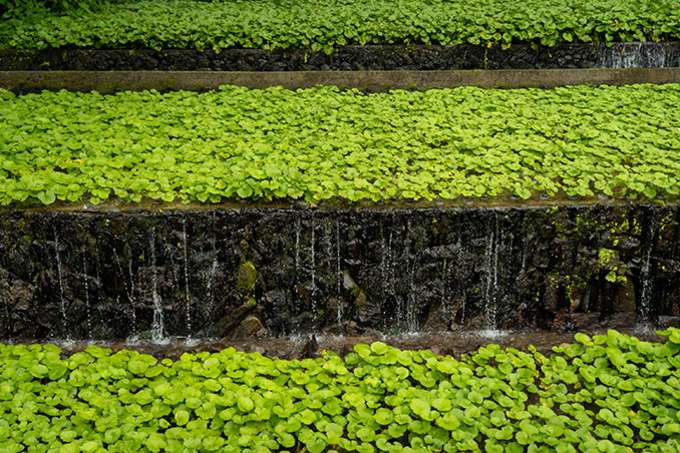
The tatamiishi system is a historic and highly sustainable farming method that has even been designated by the United Nations as a Globally Important Agricultural Heritage System, which is all the more remarkable because in Izu it is a heritage maintained by just over one hundred farming families. It is not just the humans who keep the ecosystem in good health; the local birds, butterflies, and even the Japanese clawed salamander keep pests at bay, meaning that no pesticides are needed.

In appearance, the wasabi fields are unlike typical mountain scenery. From a distance, they look like ordinary rice paddies, but on closer examination, the compact rectangular shapes of the wasabi beds surrounded by the mountains look like an extraordinary work of art. Furthermore, wasabi is evergreen, so in winter you may catch sight of it stark against the white snow; in autumn, emerald green against the blazing red of Japanese maple leaves.
Up Close and Personal with Wasabi

Having admired the wasabi from a distance, it is time to come face to face with this unusual plant. While you can admire the fields from afar you can’t enter the fields without permission since they are part of a working farm. However, there are plenty of other ways to get your wasabi fix.
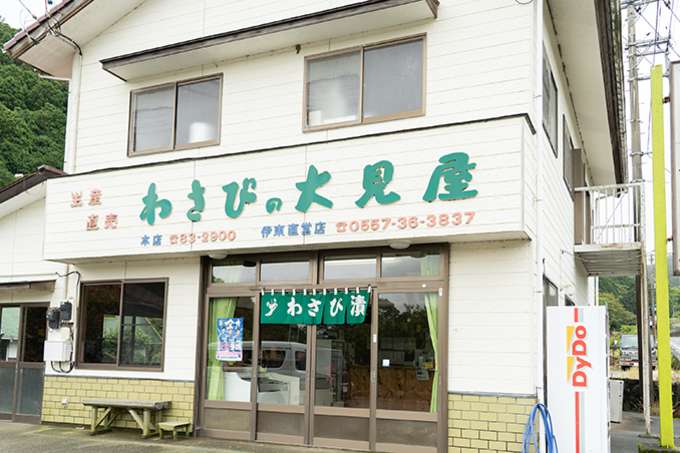
Located about 25 minutes’ drive from Shuzenji Station, your best point of entry for the Izu area, Wasabi no Omiya is one place where you can get close to the wasabi fields in the store’s expansive traditional Japanese gardens. Wasabi no Omiya holds cooking classes year-round, except in December when snow comes to the mountains.
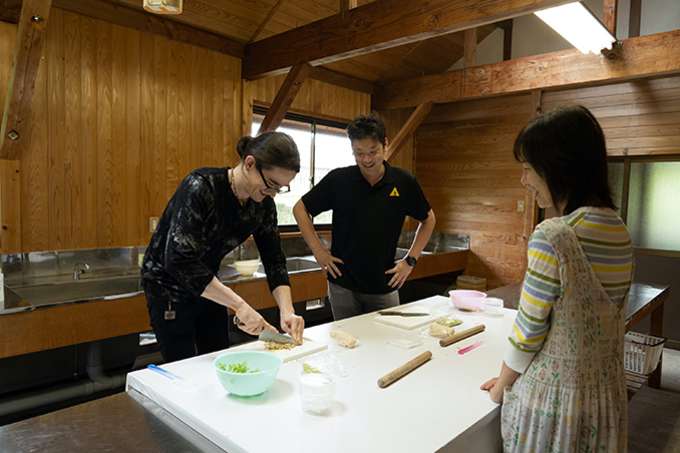
The flavor of fresh wasabi can be retained for a long time in a condiment called wasabi zuke, (pickled wasabi), where the wasabi is preserved in sake lees, a by-product of the fermentation and aging process of sake. Sake lees are surprisingly nutritious with the makings of a superfood, but more importantly, they are aromatic, which enhances the flavor of the wasabi tenfold.

First things first, you have to strip the wasabi plant right down to its roots and shoots. While every part of the wasabi plant has a place in Japanese cuisine, the roots and shoots are where that bold flavor resides.

As you chop away, the distinctive aroma of wasabi will rise to your nose, but it won’t hit you with the sharp pungency of a cheap wasabi paste. Tasting it, you will discover that the flavor of fresh wasabi is on the mellow side and builds to a clean finish.
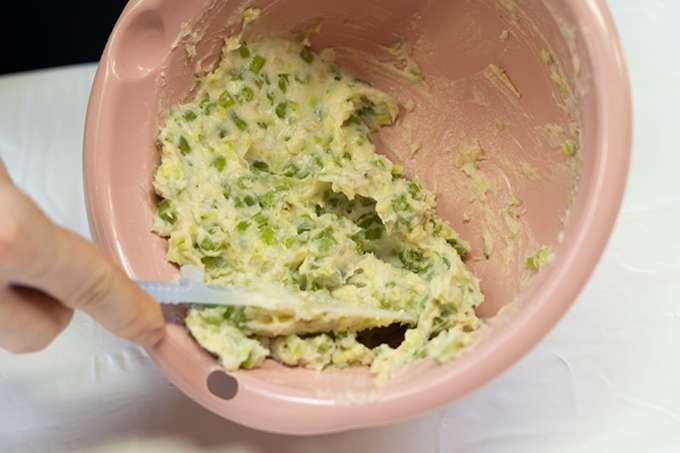
With your handiwork complete, you get to take away a decent amount of wasabi zuke to enjoy at home—more than enough to experiment with in your own cooking. Fresh wasabi isn’t all that overpowering, so you can be fairly liberal with it when you toss it into a pasta sauce, pop it into a burger, or add it to a traditional Japanese dish.

Exploring Scenic Izu

The area surrounding Izu has a good number of walking and hiking routes, with many rivers and waterfalls always nearby. Given Izu’s proximity to Mount Fuji, you are spoiled for choice with all the great views and panoramas—not only of the great cone-shaped mountain itself but also of the surrounding alpine region and the Hakone mountain range.

There is, however, one other site that you simply must not miss—Shuzenji Onsen, a small scenic town close to Shuzenji Station that has a number of scenic spots recommended by the Michelin Green Guide Japan. From the bamboo groves and historic hot springs to the stunning temple of Shuzenji with its collection of Buddhist sculptures, the aesthetics of this area have brought it much acclaim as a quintessential Japanese resort of old.

Of course, the historic hot springs beckon the traveler, as do traditional inns that date back to the samurai era in Japan, and more contemporary lodgings also exist for those staying the night before continuing on their travels. The hot springs, with over 1,200 years of history, actually predate the cultivation of wasabi in the area, although it is impossible now to imagine Izu without wasabi.

Wasabi on the Menu

Having worked with wasabi using your own hands, you should now be eager to taste it in a refined setting. One of the best dishes for highlighting the flavor of wasabi is a local specialty called wasabi don (wasabi over rice).

As you will see, there is a lot more to this dish than just wasabi and rice—it includes dried bonito flakes and nori (edible seaweed) as well as the rice, but you get to grate fresh wasabi on top of it yourself.

Thanks to the mellow, even creamy, flavor of fresh wasabi, you can afford to be relatively heavy handed when adding it.
With your own homemade wasabi zuke in your bag, it is time to continue your travels with, we hope, an appreciation for fresh Japanese wasabi and the knowledge that when you come across a wasabi root at a restaurant, it was most likely grown in the green wasabi fields of Izu.
Contact Information
Izu City Tourist Information
631-7 Kashiwakubo, Izu City, Shizuoka Prefecture 410-2407
Wasabi no Omiya
1242 Jizoudou, Izu City, Shizuoka Prefecture 410-2515
How to Get There
Izu and the Shuzenji area are best accessed from Shuzenji Station on the Izuhakone Railway Sunzu Line, which is about half an hour from Mishima Station on the JR Tokaido Shinkansen line. Mishima Station is within easy reach of every major city on Honshu with direct access from Tokyo, Nagoya, Kyoto, and Osaka. You can be at Shuzenji Station in about ninety minutes from Tokyo Station, making the Izu Peninsula surprisingly accessible despite its seeming remoteness. From Shuzenji Station, you can explore the compact area by rental bike, bus, taxi, or rental car.
Recommended Itineraries
Izu fits into any Shizuoka itinerary and is a great side trip when you are going to see Mount Fuji or when you want to indulge in Shizuoka’s fantastic green-tea culture. And once you are there, it is a shame not to spend a night at one of Izu’s many hot-spring resorts. Of these, Shuzenji Onsen is one of the most historic, and you really must spend the night to enjoy its illuminated bamboo groves or sit with your feet in one of the outdoor footbaths in the town square with the stars glittering overhead. Aside from wasabi, the photogenic town and craft shops, not to mention the local temples and shrines, offer more than enough to complete any itinerary.
Related Links
Shizuoka Wasabi Association (English)
Wasabi no Omiya (Japanese)
Map
Featured Cuisine
Wasabi has rapidly risen to global prominence as a quintessential flavor of Japan, its popularity spreading along with that of sushi. But not all wasabi is created equal—although wasabi as a paste is convenient and has a long shelf life, there is nothing quite like freshly grated wasabi, especially when done by your own hand. However you obtain it, be sure to experience the aromatic and altogether rounded flavor of fresh wasabi for yourself—mixed into traditional rustic dishes, dabbed on sushi, paired with Japanese beef, or even blended in ice cream!
-
Author
Author: Samuel
Originally from the UK, Samuel studied Japanese Studies in the UK before completing his post-graduate studies in Japan. Now with over a decade of writing about Japan for a number of publications, and teaching about Japanese art and design at university, he hopes to bring his love of Japan to a wide audience. His favorite Japanese food is takoyaki as the perfect street snack.
All information is correct as of the time of writing.
Please check for the latest information before you travel.





















































